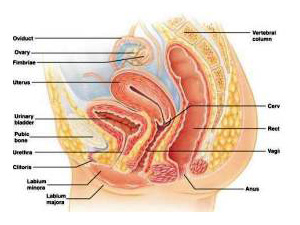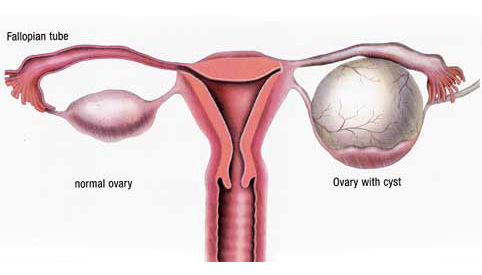Ovarian CYSTS
What is the ovary and what are ovarian cysts?
The ovary is one of a pair of reproductive glands in women that are located in the pelvis, one on each side of the uterus. Each ovary is about the size and shape of an almond. The ovaries produce eggs (ova) and female hormones. The ovaries are the main source of female hormones, which control the development of female body characteristics such as the breasts, body shape, and body hair. They also regulate the menstrual cycle and pregnancy. Ovarian cysts are closed, sac-like structures within an ovary that contain a liquid, gaseous, or semisolid substance. The ovary is also referred to as the female gonad.
What causes ovarian cysts?
Ovarian cysts form for numerous reasons. The most common type is a follicular cyst, which results from the growth of a follicle. A follicle is the normal fluid-filled sac that contains an egg. Follicular cysts form when the follicle grows larger than normal during the menstrual cycle and does not open to release the egg. Usually, follicular cysts resolve spontaneously over the course of days to months. Cysts can contain blood (hemorrhagic cysts) from injury or leakage of tiny blood vessels into the egg sac.
Another type of ovarian cyst that is related to the menstrual cycle is a corpusluteum cyst. The corpus luteum is an area of tissue within the ovary that occurs after an egg has been released from a follicle. If a pregnancy doesn't occur, the corpus luteum usually breaks down and disappears. It may, however, fill with fluid or blood and persist as a cyst on the ovary. Usually, this cyst is found on only one side and produces no symptoms.
Occasionally, the tissues of the ovary develop abnormally to form other body tissues such as hair or teeth. Cysts with these abnormal tissues are called benign cystic teratomas or dermoid cysts.
Endometriosis is a condition in which cells that normally grow inside the uterus (womb), instead grow outside of the uterus. The ovary is a common site for endometriosis. When endometriosis involves the ovary, the area of endometrial tissue may grow and bleed over time, forming a brown-colored cystic area sometimes referred to as a chocolate cyst or endometrioma.
Both benign and malignant tumors of the ovary may also contain cysts. Furthermore, the condition known as polycystic ovarian syndrome (PCOS) is characterized by the presence of multiple cysts within both ovaries. PCOS is associated with a number of hormonal problems and is the most common cause of infertility in women.
Infections of the pelvic organs can involve the ovaries and Fallopian tubes. In severe cases, pus-filled cystic spaces may be present on or around the ovary or tubes. These are known as tubo-ovarian abscesses.

What symptoms are caused by ovarian cysts?
Most ovarian cysts are never noticed and resolve without women ever realizing that they are there. When a cyst causes symptoms, painin the belly or pelvis is by far the most common one. The pain can be caused from:
rupture of the cyst,
rapid growth and stretching,
bleeding into the cyst, or
twisting of the cyst around its blood supply (known as torsion).
If the cyst has reached a large size, other symptoms may arise as a result of pressure or distortion of adjacent anatomical structures. These symptoms can include abdominal fullness or bloating, indigestion, feeling full after eating only a small amount (early satiety), feeling an urge to defecate or having difficult bowel movements, or pain with sexual intercourse.
How are ovarian cysts diagnosed?
Sometimes ovarian cysts may be noticed by a health care practitioner during a bimanual examination of the pelvis. If a cyst is suspected based upon the symptoms of physical examination, imaging techniques are used. Most cysts are diagnosed by ultrasound, which is the best imaging technique for detecting ovarian cysts. Ultrasound is an imaging method that uses sound waves to produce an image of structures within the body. Ultrasound imaging is painless and causes no harm.
Cysts can also be detected with other imaging methods, such as CT scan or MRI scan (magnetic resonance imaging).

How can the physician decide if an ovarian cyst is dangerous?
If a woman is in her 40's, or younger, and has regular menstrual periods, most ovarian masses are "functioning ovarian cysts," which are not really abnormal. Examples include follicular cysts and corpus luteum cysts. These are related to the process of ovulation that happens with the menstrual cycle. They usually disappear on their own during a future menstrual cycle. Therefore, especially in women in their 20's and 30's, these cysts are watched for a few menstrual cycles to verify that they disappear.
Because oral contraceptives work in part by preventing ovulation, physicians will not generally expect women who are taking oral contraceptives to have common "functioning ovarian cysts." Thus, women who develop ovarian cysts while taking oral contraceptives may be advised against simple observation; rather, they may receive closer monitoring with pelvic ultrasound or, less commonly, surgical exploration of the ovary. Likewise, functioning ovarian cysts are rare in women after they have reached menopause.
Other factors are helpful in evaluating ovarian cysts (besides the woman's age, or whether she is taking oral contraceptives). A cyst that looks like it is just one simple sac of fluid on the ultrasound is more likely to be benign than a cyst with solid tissue in it. So the ultrasound appearance also plays a role in determining the level of suspicion regarding a serious ovarian growth.
Ovarian cancer is rare in women younger than age 40. After age 40, an ovarian cyst has a higher chance of being cancerous than before age 40, although most ovarian cysts are benign even after age 40. CA-125 blood testing can be used as a marker of ovarian cancer, but it does not always represent cancer when it is abnormal. CA-125 is a protein that is elevated in the bloodstream of approximately 80% of women with advanced ovarian cancer.
First, many benign conditions in women of childbearing age can cause the CA-125 level to be elevated, so CA-125 is not a specific test, especially in younger women. Pelvic infections, uterine fibroids, pregnancy, benign (hemorrhagic) ovarian cysts, and liver disease are all conditions that may elevate blood CA-125 levels in the absence of ovarian cancer.
Second, even if the woman has an ovarian cancer, not all ovarian cancers will cause the CA-125 level to be elevated. Furthermore, CA-125 levels can be abnormally high in women with breast, lung, and pancreatic cancer.

What are the risks of ovarian cysts during pregnancy?
Ovarian cysts are sometimes discovered during pregnancy. In most cases, they are found as an incidental finding at the time of routine prenatal ultrasound screening. The majority of ovarian cysts found during pregnancy are benign tumors that do not require surgical intervention. However, surgery may be indicated if there is a suspicion of malignancy, if an acute complication such as rupture or torsion (twisting of the cyst, disrupting the blood supply) develops, or if the size of the cyst is likely to present problems with the pregnancy.
Ovarian Cysts At A Glance
Ovarian cysts closed, sac-like structures within the ovary that are filled with a liquid, semisolid, or gaseous substance.
Ovarian cysts form for numerous reasons.
When a cyst causes symptoms, pain in the belly or pelvis is by far the most common one.
Most cysts are diagnosed by ultrasound.
The treatment of ovarian cysts depends upon the individual situation and varies from observation and monitoring to surgical procedures.




